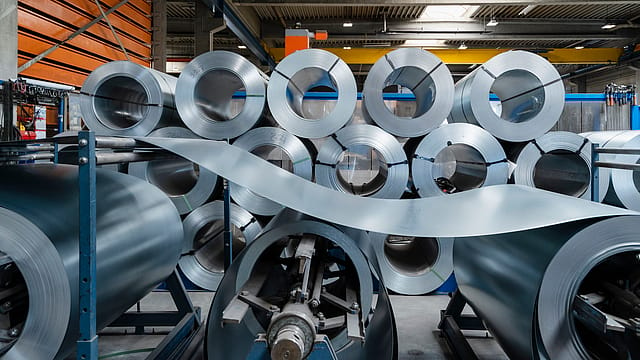India's steel exports to fall 25% in FY23: ICRA
ADVERTISEMENT

India's finished steel exports are expected to decline by 25% year-on-year in the financial year 2022-23, after two back-to-back years of earnings surge witnessed by steelmakers, according to rating agency ICRA.
The decline is likely to be more pronounced in highly competitive markets like Southeast Asia and the Middle East compared to Europe, where export offers typically are higher, the rating agency says while revising the sector’s outlook to "stable" from "positive".
This comes after the government imposed export duty on a range of finished steel products to rein in rising domestic prices. To improve domestic steel availability, the Centre imposed a 15% export duty on finished steel products in May. It also hiked export duty on iron ore fines and lumps from 30% to 50%.
In FY22, Indian mills recorded a 25% year-on-year growth in finished steel exports as they took the benefit of elevated seaborne prices. Europe, Vietnam and the Middle East were the three largest destinations for Indian steel exports, together accounting for around 50% of India's overall steel exports.
Steel companies are now staring at a significant decline in earnings over the next twelve months as the industry faces multiple headwinds emanating from trade barriers from export duty on finished steel, unprecedented energy cost pressures, and muted domestic demand growth so far, says ICRA.
December 2025
The annual Fortune 500 India list, the definitive compendium of corporate performance, is out. This year, the cumulative revenue of the Fortune 500 India companies has breached $2 trillion for the first time. Plus, find out which are the Best B-schools in India.
The steel industry could be on the way to an accelerated mean reversion as the operating environment becomes far less attractive in the coming months, according to ICRA's latest note on the sector. "Such challenges would be accentuated by high inflation and front-loading of policy rate hikes," the rating agency says.
ICRA also revised downwards the domestic steel industry's overall operating profits for the current fiscal by around 30% compared to the previous estimate made before the Russia-Ukraine conflict, as margins get squeezed between lower steel prices and elevated input costs.
"The steady rise in coking coal costs had started to nibble at the margins of steelmakers even before the export duty was announced… With domestic hot rolled coil prices correcting by around 9% since the imposition of the export duty, and with coking coal consumption costs poised to spike by around 30- 35% quarter-on-quarter, notwithstanding the correction in domestic iron ore prices, the industry's operating profits are expected to sequentially decline by $80-90 per MT in Q1 FY2023," says Jayanta Roy, senior vice-president and group head, Corporate Sector Ratings, ICRA.
While the margin pressure is likely to persist in the seasonally weak second quarter when steel prices would remain under pressure, the correction in coking coal spot prices by around 27% in the last three weeks augurs well for steelmakers' second half margins when demand conditions improve, Roy adds.
Steelmakers are also exploring the possibility of switching to export of value-added/ alloy steel categories which are out of the ambit of duties.
India's domestic steel demand, after reaching an average run-rate of 9.7 million tonnes (MT) per month in Q4 FY22, has sequentially slowed down somewhat in the current quarter, when it recorded a lower average run rate of 9.3 MT/month during April-May 2022.
While demand has remained weaker than expected at the start of year, a pick-up in infrastructure spending in core sectors like railways, roadways, multimodal logistics parks, and energy has the potential to spur demand for steel in the second half of the fiscal, especially with the significant fall in domestic steel prices.
On the import front, with competition heating up in the domestic market, and domestic hot rolled coil prices trading at a discount of around $110-120/MT over the landed cost of Chinese export offers, India’s overall finished steel imports are expected to contract by around 10% Y-o-Y in FY23.
